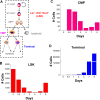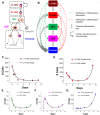A computational model of feedback-mediated hematopoietic stem cell differentiation in vitro
- PMID: 30822334
- PMCID: PMC6396932
- DOI: 10.1371/journal.pone.0212502
A computational model of feedback-mediated hematopoietic stem cell differentiation in vitro
Abstract
Hematopoietic stem cells (HSCs) play an important physiological role as regulators of all blood and immune cell populations, and are of clinical importance for bone marrow transplants. Regulating HSC biology in vitro for clinical applications requires improved understanding of biological inducers of HSC lineage specification. A significant challenge for controlled HSC expansion and differentiation is the complex network of molecular crosstalk between multiple bone marrow niche components influencing HSC biology. We describe a biology-driven computational approach to model cell kinetics in vitro to gain new insight regarding culture conditions and intercellular signaling networks. We further investigate the balance between self-renewal and differentiation that drives early and late hematopoietic progenitor populations. We demonstrate that changing the feedback driven by cell-secreted biomolecules alters lineage specification in early progenitor populations. Using a first order deterministic model, we are able to predict the impact of media change frequency on cell kinetics, as well as distinctions between primitive long-term HSCs and differentiated myeloid progenitors. Integrating the computational model and sensitivity analyses we identify critical culture parameters for regulating HSC proliferation and myeloid lineage specification. Our analysis suggests that accurately modeling the kinetics of hematopoietic sub-populations in vitro requires direct contributions from early progenitor differentiation along with the more traditionally considered intermediary oligopotent progenitors. While consistent with recent in vivo results, this work suggests the need to revise our perspective on HSC lineage engineering in vitro for expansion of discrete hematopoietic populations.
Conflict of interest statement
The authors have declared that no competing interests exist.
Figures





Similar articles
-
Hematopoietic stem cell lineage specification.Curr Opin Hematol. 2016 Jul;23(4):311-7. doi: 10.1097/MOH.0000000000000260. Curr Opin Hematol. 2016. PMID: 27135980 Review.
-
Differentiation-based model of hematopoietic stem cell functions and lineage pathways.Blood. 2018 Sep 13;132(11):1106-1113. doi: 10.1182/blood-2018-03-791517. Epub 2018 Jul 24. Blood. 2018. PMID: 30042097 Free PMC article. Review.
-
Purine metabolism in bone marrow microenvironment inhibits hematopoietic stem cell differentiation under microgravity.Stem Cell Res Ther. 2025 Mar 5;16(1):115. doi: 10.1186/s13287-025-04213-9. Stem Cell Res Ther. 2025. PMID: 40038750 Free PMC article.
-
Co-cultured hBMSCs and HUVECs on human bio-derived bone scaffolds provide support for the long-term ex vivo culture of HSC/HPCs.J Biomed Mater Res A. 2016 May;104(5):1221-30. doi: 10.1002/jbm.a.35656. Epub 2016 Feb 12. J Biomed Mater Res A. 2016. PMID: 26779960
-
Hematopoietic Stem Cells, Their Niche, and the Concept of Co-Culture Systems: A Critical Review.J Stem Cells. 2015;10(1):13-31. J Stem Cells. 2015. PMID: 26665935 Review.
Cited by
-
Computational modeling of stem and progenitor cell kinetics identifies plausible hematopoietic lineage hierarchies.iScience. 2021 Jan 29;24(2):102120. doi: 10.1016/j.isci.2021.102120. eCollection 2021 Feb 19. iScience. 2021. PMID: 33665548 Free PMC article.
-
Optimal experimental design for mathematical models of haematopoiesis.J R Soc Interface. 2021 Jan;18(174):20200729. doi: 10.1098/rsif.2020.0729. Epub 2021 Jan 27. J R Soc Interface. 2021. PMID: 33499768 Free PMC article.
-
Engineered Tissue Models to Replicate Dynamic Interactions within the Hematopoietic Stem Cell Niche.Adv Healthc Mater. 2022 Apr;11(7):e2102130. doi: 10.1002/adhm.202102130. Epub 2022 Jan 7. Adv Healthc Mater. 2022. PMID: 34936239 Free PMC article. Review.
-
HDAC6 deacetylates IDH1 to promote the homeostasis of hematopoietic stem and progenitor cells.EMBO Rep. 2023 Oct 9;24(10):e56009. doi: 10.15252/embr.202256009. Epub 2023 Aug 29. EMBO Rep. 2023. PMID: 37642636 Free PMC article.
-
Effective Drug Concentration and Selectivity Depends on Fraction of Primitive Cells.Int J Mol Sci. 2021 May 6;22(9):4931. doi: 10.3390/ijms22094931. Int J Mol Sci. 2021. PMID: 34066491 Free PMC article.
References
Publication types
MeSH terms
Grants and funding
LinkOut - more resources
Full Text Sources
Medical

